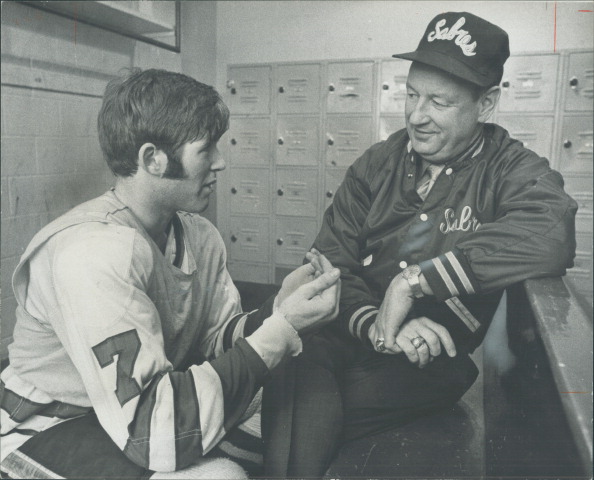Hockey fans know of NHL legends. They know the names Gretzky, Lemieux, Richard, and Orr even if they never saw them play. Heck, it doesn’t take much to learn about lesser-known legends from all teams. Take the Buffalo Sabres for example. Names like Gilbert Perreault, Rick Martin, Rene Robert and Dominik Hasek are (they should be) well known in the hockey world. Still, there is one legend that has slipped through the cracks. One Sabres hero that too many have forgotten. This is the legend of Taro Tsujimoto.
The Legacy of Taro Tsujimoto
What, you have never heard of Sabres legend Taro Tsujimoto? It’s not really that surprising but we will get to that. If you are a Buffalo Sabres fan, however, you are (you should be) aware of this folk hero. The origins of Tsujimoto go back to the mid 70’s when the NHL was in a bitter war with a rival league, drafts were conducted in secret and overseas scouting was in its infancy.
Setting the Table
The year was 1974. The NHL was in a bitter war with the upstart WHA. It was a war over money, markets, players and ultimate hockey glory. The WHA forced the NHL into many changes that the owners were not so excited about. The WHA was throwing big money at some of the NHL’s top stars to lure them to the new league. This forced the typically stingy NHL owners to open up their pocketbooks a little more to keep their top stars. In 1973 the WHA began to sign underage players before they could enter the NHL draft. The upstart league was poaching the stars of tomorrow before the NHL even had a chance to pick them. The WHA was forcing the NHL owners to adapt or lose out on big-name prospects. So adapt they did in 1974.
1974 Draft
So why is all this WHA vs NHL business important? Well, in 1974, in response to the WHA’s signing underage players, the NHL had their amateur draft, early and in secret. Along with it being early and in secret, the draft was also conducted by conference call at an intentionally slow pace. The league rules for the draft then were as long as a team was still picking a player, the draft would go on. None of that fancy seven rounds and it’s over drafting we have today. This was a war of attrition. It was also done as a way of trying to hoard players to prevent the WHA from poaching or tampering with the amateur players. All the secrecy didn’t work as picks were leaked by agents but all these preventative measures led to the birth of a legend.
25 Rounds?
Today the NHL draft is 7 rounds and takes place over two days. The 1974 draft ended up having 25 rounds (!) and took place over three days. That is a lot of drafting in a short time. Especially since most people know there is a very minuscule chance a player drafted in the 5th round will make the NHL, these poor souls had to pour over scouting reports for 25 rounds. Thanks a lot, WHA! Or should we thank NHL commissioner Clarence Campbell who implemented all these rules? How about both.
Anyway, the tedium of any draft can take a toll on general managers and scouting departments who have to sit around during this whole thing. So by the 11th round and the Sabres felt like they might as well throw a dart at a dartboard to make their next pick. George ‘Punch’ Imlach the head coach and general manager of the Sabres decided to go WAY off the board with the 183rd pick. He called in and selected an extremely unknown center from the Japanese Ice Hockey League. His name was Taro Tsujumoto. He was the first player from Japan to be selected in the NHL draft. That alone would be enough, but this legend goes deeper than that.
Who is Taro Tsujimoto
Once the Sabres made the pick it was validated by the league and the questions began. Who is this guy? All anyone knew was he was a pint-size 5’8″ 180-pound center that played for the Tokyo Katanas of the JIHL. To be fair, that is all anyone really knows about this kid. And that’s the rub… but more on that in a little bit.
Foreign Scouting
At the time the other teams scoffed and laughed at the (way) outside-the-box pick. Foreign scouting was just starting and the vast majority of players were from North America. The USSR was off-limits for the NHL so the only real place teams would even consider was Scandinavia. Granted this pick was made while the search for NHL players was expanding beyond North America and teams could scout just about anywhere, so the possibility of picking someone nobody knew of was higher than it would be in today’s scouting world. Still, for a team to look to Asia, not a hockey hotbed by any stretch raised a Spockian eyebrow from more than one team, especially with their coveted 11th-round pick.
Seriously, Who Is This Guy?
A funny thing can happen to people when they are cooped up in a room for too long. Say for days on end having to look at thousands of scouting reports for players that are probably not going to make it to the NHL. I mean taking a long process like an amateur draft and making it longer, both in terms of rounds and pace, might make someone a bit frustrated, especially if they believe the draft had little value after the fifth round. They might look to make a statement about how silly all of this was. They might also look to have a little fun. That’s what the Sabres did. Imlach so frustrated with the way the draft was running decided to draft a made-up player. Taro Tsujimoto is not real.
Not sure how this happened? Well as mentioned NHL overseas scouting was in its infancy so there were no databases of players and not every prospect was known to scouts. It is very possible there was a Japanese player they wanted to draft. The league didn’t know better and why would anyone submit a fake player to be drafted. And if we are being honest, most teams were probably seeing triple by the time the pick was made and just wanted the draft to keep moving. So while there were a lot of skeptics, it was approved by the league and reported by the press and they kept going.
Creating a Legend
So how does someone go about creating a fake player on a fake team? Well, first you need a name. Enter Sabres PR Director Paul Weiland. While he was in College, Weiland used to pass by the Tsujimoto store and the name always stuck with him. So they had their last name but they want to make sure they could use it. Imlach called the Tsujimoto store and spoke with the owner, Joshua, to ask if they could use his name. He agreed. While they had him, they also asked what a popular Japanese first name was and were told Taro. Before the conversation ended, the Sabres asked what the Japanese word for a sabre was. Joshua replied Kitana – a Japanese sward.
So the very fake Taro Tsujimoto played for the very fake Tokyo Kitanas. Still, to give this a whiff of legitimacy, the Kitanas played in the very real JIHL. The pride of Tokyo was born.
The Fall Out
There was no REAL fall out here. The joke was kept alive for a few months by the Sabres. The press would ask about Tsujimoto and Imlach would simply reply “he’s coming”. Tsujimoto was listed on the Sabres training camp roster. The team even set up a stall for him. The mystique around Tsujimoto only added to his legend. The charade could not last, however. Just before training camp, Imlach has to reveal the truth, there is no Taro Tsujimoto. NHL commissioner Clarance Campbell did not find the joke all that funny. He switched the pick in the official records to ‘invalid’.
The Man, the Myth, the Legend
Tsujimoto became a type of inside joke amongst Sabres fans. Chants of ‘WE WANT TARO’ could break out during games, they would bring banners with ‘Taro Says…” followed by some witty comment about an opponent and even created their own Tsujimoto jerseys. The legend continued to grow in 2011 when trading card company Panini issued a Taro Tsujimoto rookie card to their Score hockey card set.
The Tsujimoto affair is one of the more funny episodes in NHL history and is something that could never happen today so let’s appreciate the originality and creativity of the Sabres to pull this off. And while Tsujimoto is not a real player, his legend lives on still.






